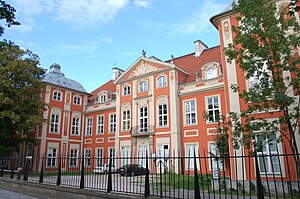Czapski Palace
| Czapski Palace Pałac Czapskich w Warszawie (Polish) |
|
|---|---|

Czapski Palace, side view
|
|
| General information | |
| Architectural style | Rococo |
| Town or city | Warsaw |
| Country | Poland |
| Construction started | 1686 |
| Completed | 1705 |
| Demolished | 1939 |
| Design and construction | |
| Architect | Tylman Gamerski |
The Czapski Palace (Polish: Pałac Czapskich, IPA: [ˈpawat͡s ˈt͡ʂapskʲix]), also called the Krasiński, Sieniawski or Raczyński Palace, is a substantial palace in the center of Warsaw, at 5 Krakowskie Przedmieście. It is considered one of the most distinguished examples of rococo architecture in Poland's capital.
The building, just across the street from the University of Warsaw, has been home to famous persons including artist Zygmunt Vogel, composer Frédéric Chopin, and poets Zygmunt Krasiński and Cyprian Norwid.
The palace now houses the Warsaw Academy of Fine Arts.
"Czapski Palace" is the name most often applied to the building, but in reference to subsequent residents it is also sometimes called the Krasiński,Sieniawski or Raczyński Palace. The building has also been owned by the Radziwiłłs, Radziejowskis, Zamoyskis and Czartoryskis.
Now the home of the Warsaw Academy of Fine Arts, the Czapski Palace dates from the late 17th century. It was constructed in about 1686 to Tylman van Gameren's design for Michał Stefan Radziejowski, Archbishop of Gniezno and Cardinal Primate. Between 1712 and 1721 it was reconstructed by Agostino Locci and Kacper Bażanka (alcoves and breaks were added) for the next owner, Great Crown Hetman Adam Mikołaj Sieniawski. Its present rococo character dates from 1752–65, when the palace belonged to the Czapski family. At that time, the Krakowskie Przedmieście entrance was decorated with eagles and allegorical figures of the Four Seasons.
...
Wikipedia
